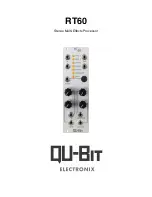
Calibration – Cable Calibration
39
The current contributions from each source on the above list are (at most) a few pA, so they are insignificant on
all but the most sensitive Reference 3000 current range: the 300 pA range.
This effect can cause differences of up to 8 pA between DC current measured with the cell turned off and
current measured with the cell turned on. In most cases the difference is smaller: one or two pA.
Only two Reference 3000 applications are sensitive enough that this current measurement offset causes
problems. One is Physical Electrochemistry (Cyclic Voltammetry for example) with small electrodes, and the
other is EIS on high-impedance samples such as barrier coatings. Incorrect DC current readings in EIS can slow
the experiment, for the automatic ranging algorithms in the Electrochemical Impedance Spectroscopy software
can make poor range-choices given incorrect data. This can significantly lengthen the time needed to measure
an EIS spectrum.
Most corrosion experiments or macro-electrode measurements involve currents much too large to be affected
by this difference.
The Gamry Framework also includes a special “Low I DC Current” calibration procedure that corrects the
Reference 3000 offsets to minimize this problem. The procedure uses a script that:
1)
Asks you to disconnect the reference, counter, and counter sense leads from the calibration cell,
2)
Measures the I/E input and Working sense amp input currents on the 300 pA range,
3)
Replaces the 300 pA current range offset measured in the full DC calibration with the improved value.
The error sources listed above are both time- and temperature-dependent, so we recommend frequent “Low I
DC Calibration”—if you need accurate measurement of absolute currents at pA levels. The procedure runs
fairly quickly, so daily, or weekly calibration ought not be too inconvenient.
Cable Calibration
This procedure uses the external resistive 2 kΩ Calibration Cell as shown in Figure 5-1.
Cable calibration is only required infrequently, if you feel that the cable capacitance is a problem for your
experiments, especially if you see excessive phase glitches on high-impedance samples.
Caution:
The Reference 3000 cable calibration calls for an external resistive Calibration
Cell. Your Reference 3000 was shipped with a 2 kΩ Calibration Cell including a 2 kΩ, 0.05% accurate
resistor. After calibration, please place this Calibration Cell in a safe place where you can find it if your unit
requires recalibration.
The Low I DC Calibration is not a full calibration. You must run a
full
DC Calibration on your
Reference 3000
before
you run the Low I DC calibration. Remember that the Reference 3000 must have a
full DC calibration on the
same type of cable
you use for the Low I DC Calibration.
















































